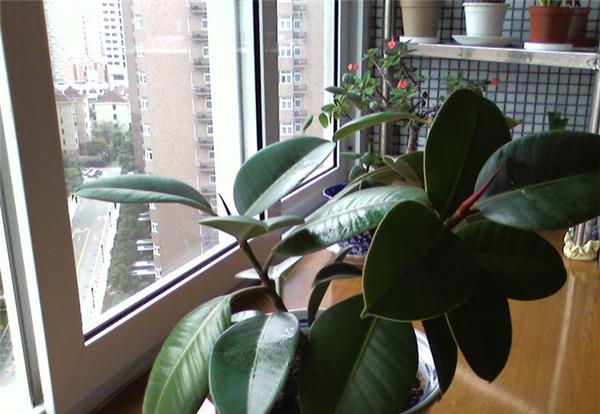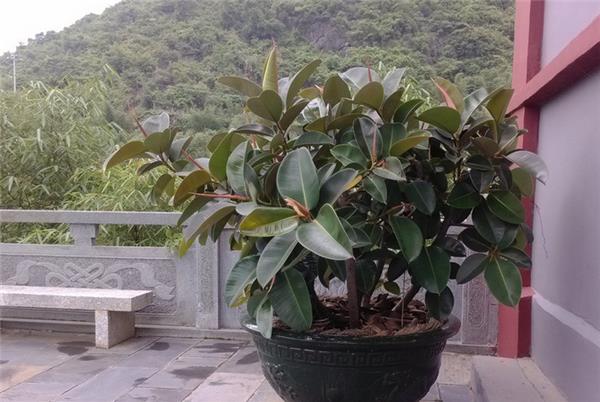[culture methods and points for attention of rubber trees] how to raise rubber trees
The leaves of the rubber tree are thick and beautiful, broad, beautiful and shiny, and the red top is like a floating cloud. Rubber tree has high ornamental value and is one of the famous indoor potted foliage plants. Rubber trees have strong adaptability to light and are very suitable for beautification and layout in darker rooms.

I. Culture methods of rubber trees
The Culture method of Rubber Tree: sunshine
It is said that the sun is the food of plants is really good, in the rubber tree culture method, the sun is also a treasure, give it enough sunshine to let it thrive. Proper shading from May to September.
Fertilization of culture methods of rubber trees
The existence of fertilizer, like calcium supplement, can enhance its "health". Fertilization is also one of the key points in rubber tree breeding methods, which can reduce the occurrence of markings and make the leaves bright. Just use nitrogen fertilizer, and remember to stop applying fertilizer in winter.
Pruning and turning pots in the culture methods of rubber trees
The arrival of spring when it is time for pruning, the rubber tree cuts off the branches inside the crown, inward branches and thin branches to maintain its internal ventilation, good light transmission and overall shape. Usually, in the cultivation method of rubber tree, the basin must be turned once every 2 years, and materials such as rotten leaf soil are added to reconfigure it. It likes loam soil with loose and good drainage.

Matters needing attention in the culture of rubber trees
The main results are as follows: 1. the top advantage of rubber tree is strong, so it should be pruned in time to promote its lateral branches.
2. Rubber trees can also tolerate shade, variegated leaf varieties need bright light every day, otherwise the leaf color is not good.
3. The leaves of rubber trees fall off suddenly: the species of tree type may be overwatered; the winter temperature is too low; the fertilization is too much and too thick; and the sudden cold wind blows. The type of hanging type may be that the light is too weak, or it may be moved from a suitable environment to another environment.
4. The lack of nitrogen fertilizer in rubber trees will lead to the shedding of the lowest old leaves, so fertilizers should be replenished in time.
5. Diammonium hydrogen phosphate and potassium dihydrogen phosphate should be used as topdressing in the vigorous growth season.

Third, the role of rubber trees in the center of the home
Now the living environment is polluted, and the rubber tree has the function of purifying dust and can absorb formaldehyde. Not only that, the rubber tree can also effectively absorb carbon monoxide, carbon dioxide and other harmful gases in the air, so that indoor air can be purified. Rubber trees can carry out photosynthesis and transpiration in sunny places, regulating air humidity and oxygen content. For dusty and unventilated homes, it is most suitable to put rubber trees by the window.
The rubber tree gives the eyes a rest. It is a big evergreen tree. Bark smooth, branchlets green, less branched. Leaves oval, about 15 cm long, thick leathery, apex obtuse tail tip, base round, page dark green, with grayish green or yellowish white markings brown spots, light green back.
The rubber tree is about 2 meters high, the stem is glabrous and has milk. The leaves of the rubber tree are thick and beautiful, the leaves are broad, beautiful and shiny, the red top is like Fuyun, and the stipules are like red tassel drooping after cracking. The rubber tree has strong vitality, which makes people have a feeling of continuous self-improvement. The shape of the rubber tree is beautiful and can decorate the home.

The rubber tree is a green vacuum cleaner. When some plants are placed in a closed room, the rate of dust reduction is much faster than when there are no plants. The dust in indoor air mainly comes from the wear and heating of smoking, heating, cooking, office equipment and building materials.
- Prev

[culture methods and matters needing attention of Phyllostachys pubescens] how to raise Phyllostachys pubescens
[culture methods and matters needing attention of Phyllostachys pubescens] how to raise Phyllostachys pubescens
- Next

[planting method of Canna] how to raise Canna
[planting method of Canna] how to raise Canna
Related
- Wuhan Hospital Iron Tree Blooming Result Was Instantly Frightened by the Gardener Master
- Which variety of camellia is the most fragrant and best? Which one do you like best?
- What is the small blue coat, the breeding methods and matters needing attention of the succulent plant
- Dormancy time and maintenance management of succulent plants during dormancy
- Minas succulent how to raise, Minas succulent plant pictures
- What are the varieties of winter succulent plants
- How to raise succulent plants in twelve rolls? let's take a look at some experience of breeding twelve rolls.
- Attention should be paid to water control for succulent plants during dormant period (winter and summer)
- Watering experience of twelve rolls of succulent plants
- Techniques for fertilizing succulent plants. An article will let you know how to fertilize succulent plants.

